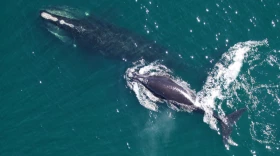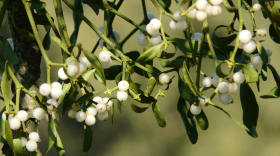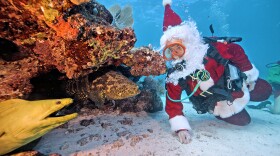Floridians are very familiar with the buzzing sound in their ears and the sting from a mosquito bite. It could be worse if not for the pesticides that every county uses to combat the insect.
However, as humans continue to modernize methods to control mosquitoes, those methods can cause issues up and down the food chain. Dr. Melissa May and lab assistant Kenzie Pruitt with The Water School at Florida Gulf Coast University are discovering how local pesticide usage impacts Gulf waters by testing local waterways.
"Obviously mosquitoes are a big deal here. So there's a lot of insecticides that target mosquitoes," said Pruitt. "A lot of those active ingredients include something called pyrethroids, which are a synthetic man-made version of a natural compound derived from chrysanthemum flowers."
The ingredients sound natural and organic, she said. "However, there's a man-made version of that compound that is actually very toxic to marine species, specifically fish."
Melissa May with The Water School agreed, saying the key pesticide they're researching is permethrin.
"They don't metabolize it like they do some of the other organic contaminants," said May. "And it can cause mortalities."
So, the research entails three questions: Are there pesticides at Kimberly's Reef in the water? Are the compounds found in fish at the reef? And if so, how they are impacting the physiology of the reef fish?
About eight miles from shore in the Gulf, Kimberly's Reef is an underwater classroom and laboratory created by Florida Gulf Coast University. The artificial reef comprises six "villages" of concrete culverts used for a variety of research topics.
The first step in the research for pesticides was determining how pervasive those chemicals are in the Gulf. Pruitt tested waters from the Caloosahatchee River and Estero Bay in Lee County and at Wiggins Pass in Collier County. She took samples every two miles out to Kimberly's Reef.
"We would expect the pesticides would be higher, closer to shore, and as they move further offshore, they get diluted out," said May.
The samples revealed a surprise about where a lot of the pesticides were flowing from.
"It seems like they're coming from Wiggins Pass instead of from the Caloosahatchee River, and we did find pesticides at Kimberly's Reef in the water," she said.
Pruitt then used living fish from an aquarium for the experiment. She began by giving small doses of pyrethroid permethrin to the fish every day for a week. The fish were then terminated so Pruitt could dissect them and determine the pesticide exposure to various tissues.
"Mostly the gill, if they're being exposed to it through the water, obviously it's through gills," said Pruitt. "And then the muscle is more like long-term storage, so if it stays in their body long enough, it'll get worked into that."
Testing for pesticides could have broader impacts in various waterways, according to Pruitt, especially in estuaries such as Estero Bay, where juvenile fish live in nurseries.
"They could accumulate those pesticides and then move out to the reef as adults, sort of migrating outwards towards the open waters, and take those pesticides there," said Pruitt. "Then, for instance, a bigger fish could eat that fish, and then it could slowly work its way up into the possible human food web."
May said this research at the Water School is ongoing and could help in the future health of Southwest Florida waters.
"We tend to blame everything on the Caloosahatchee and Lake Okeechobee, but there's lots of other impaired waterways that can contribute to pollution. Her study will help us understand where those are coming from, which could help with management practices."
Dispatches from Kimberly's Reef are part of a WGCU documentary project about the reef due out in 2026.The Kimberly's Reef documentary project is generously and partially funded by Bodil and George Gellman.














